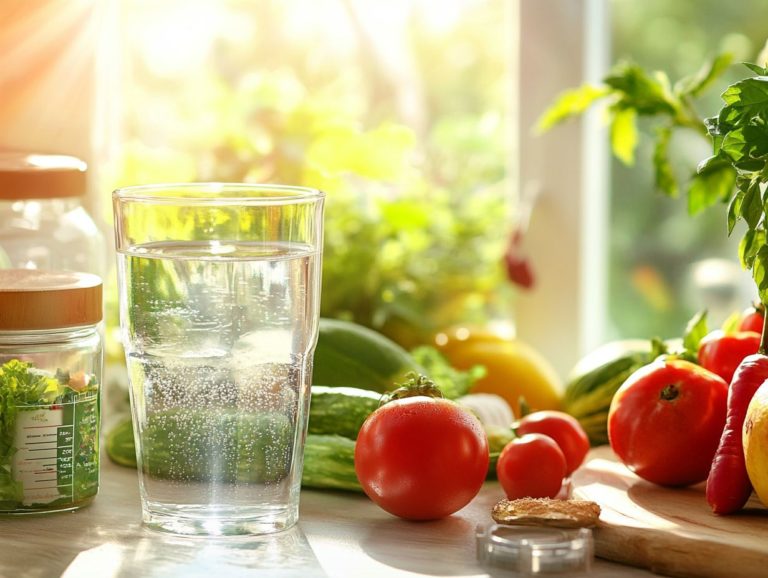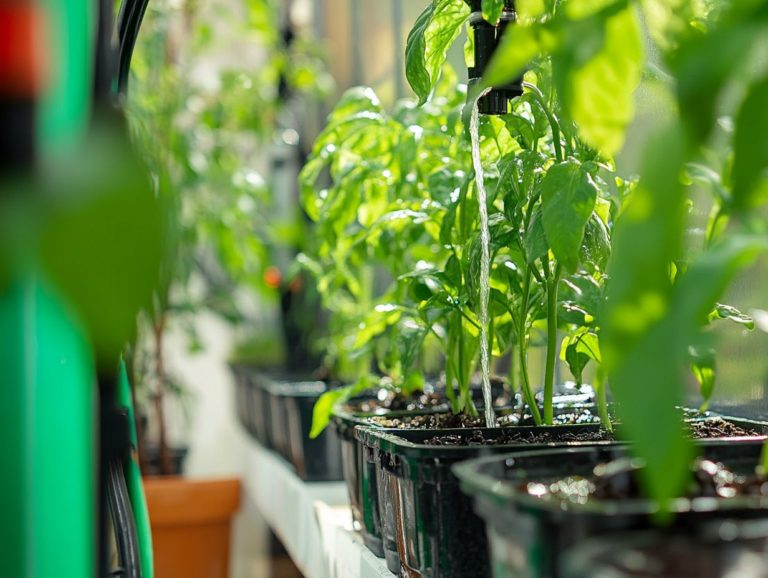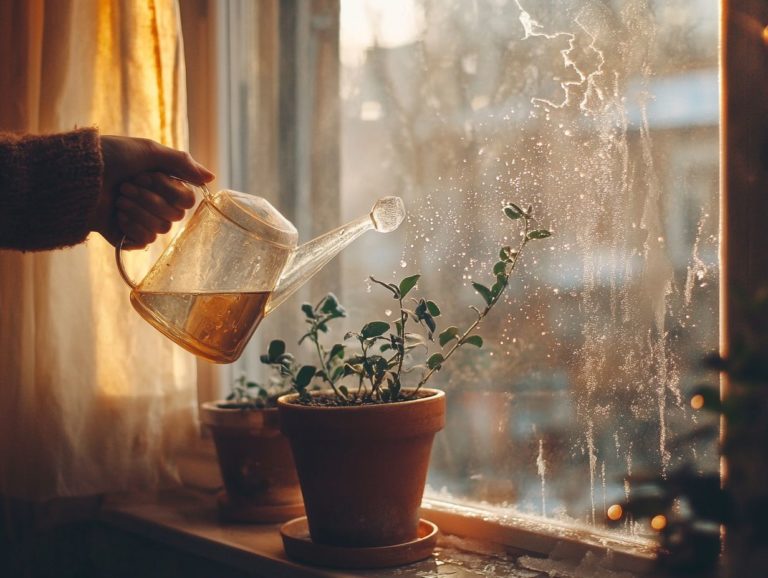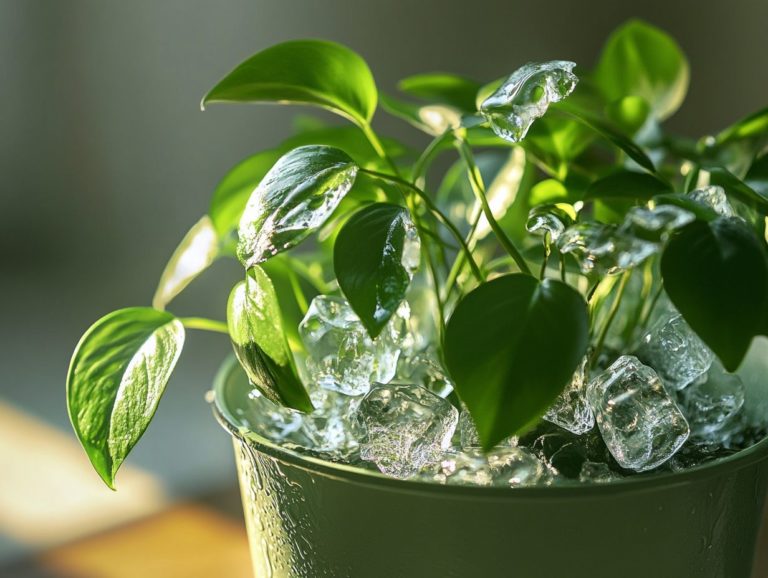How to Tell if Your Plant is Underwatered
Keeping your plants healthy and vibrant hinges on grasping their unique water needs, especially as a plant parent.
Let s explore the key factors that influence how much water your plants actually require, guiding you to identify the signs of underwatering everything from visual cues to subtle behavioral changes.
You ll discover effective watering practices and expert tips to prevent underwatering before it becomes a problem. Should you find your plants in distress, rest assured there are strategies at your disposal to help revive them.
Embrace this journey and elevate your confidence as a plant caregiver!
Contents
- Key Takeaways:
- Understanding Plant Water Needs
- Signs of Underwatering
- How to Properly Water Your Plants
- Preventing Underwatering
- Dealing with Underwatered Plants
- Frequently Asked Questions
- What are the signs that my plant is underwatered, and how can I differentiate them from symptoms of overwatering?
- Can underwatered plants be saved?
- How often should I water my plants?
- Are there any common mistakes that can lead to underwatering?
- Can overwatering mimic the symptoms of underwatering?
- What should I do if I suspect my plant is underwatered?
Key Takeaways:
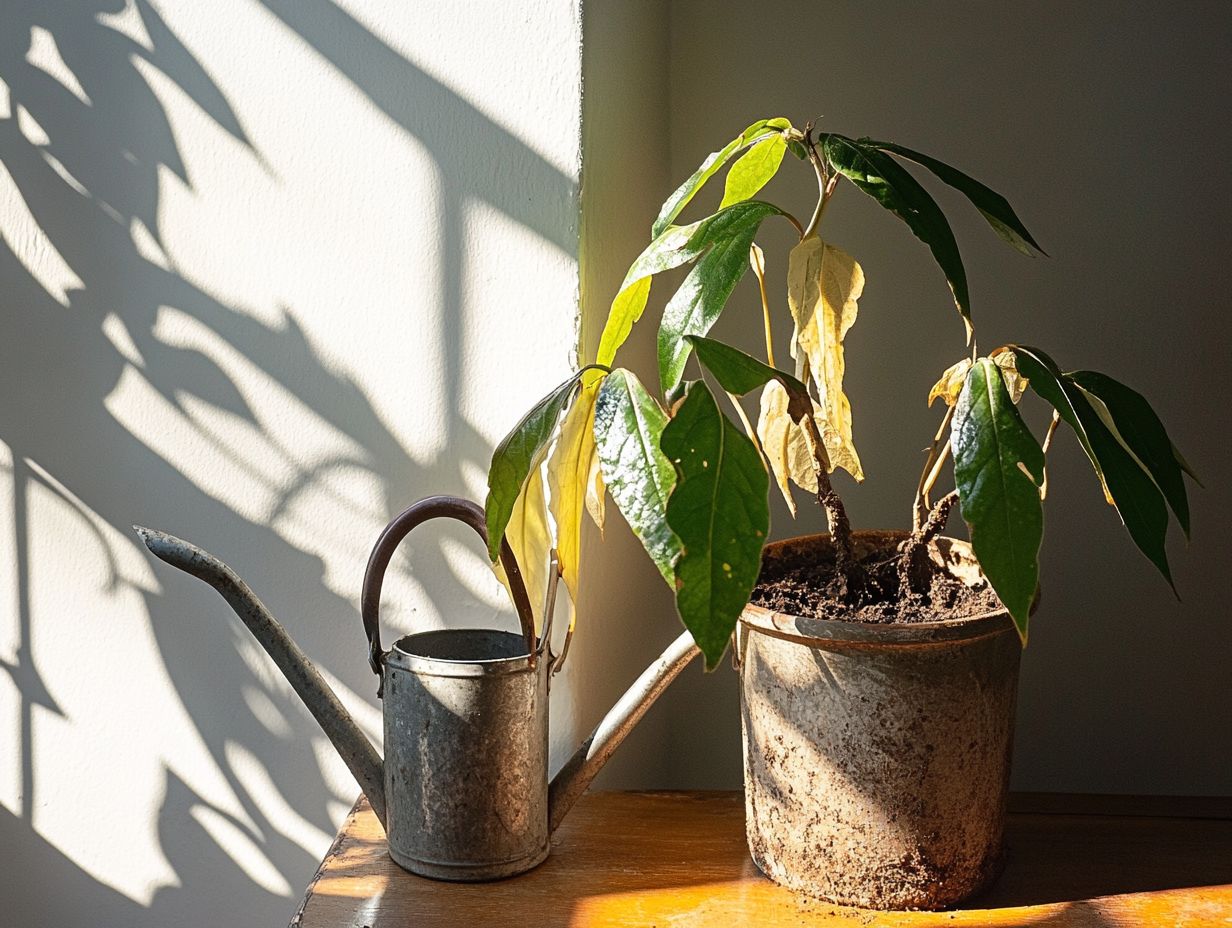
- Pay attention to visual cues such as wilting leaves and dry soil to determine if your plant is underwatered.
- Proper watering techniques, such as watering deeply and consistently, can prevent your plant from becoming dehydrated.
- If your plant is already underwatered, revive it by watering deeply and gradually increasing watering frequency until it shows signs of recovery.
Understanding Plant Water Needs
Understanding the water needs of your plants is essential if you aim to cultivate thriving houseplants. Your watering habits play a crucial role in their growth. By being attentive to factors such as humidity and soil moisture, you can sidestep potential problems like wilting, yellowing leaves, and root rot.
Knowing when and how much to water is key to a thriving peace lily. Don t overlook factors like temperature and light; they greatly affect your plants water needs.
Factors that Affect Water Requirements
Several factors influence the water requirements of your plants, including soil type, drainage capabilities, humidity levels, and overall climate conditions. These variables are essential to ensuring your plants receive the right amount of hydration for optimal growth.
For instance, if you’re working with sandy soils, they drain quickly, necessitating more frequent watering. In contrast, clay soils can hold onto moisture, which may lead to overwatering if you’re not vigilant. Efficient drainage systems can prevent excess water accumulation and safeguard against root rot, especially during heavy rains.
Environmental conditions, such as temperature and humidity, significantly impact how much water plants lose. During hot, dry spells, you may need to provide your plants with extra sustenance to prevent wilting. In a greenhouse with high humidity, evaporation rates decrease, which can alter your watering schedules compared to outdoor gardens facing unpredictable weather patterns.
Signs of Underwatering
Recognizing the signs of underwatering is crucial! Look for wilting leaves and dry soil they re clear signals your plant needs immediate help.
Additionally, dry soil is a significant indicator of trouble. Regularly checking the soil ensures you catch any issues early, preventing more serious consequences that could hinder your plant s growth and overall vitality.
Visual Cues and Changes in Plant Behavior
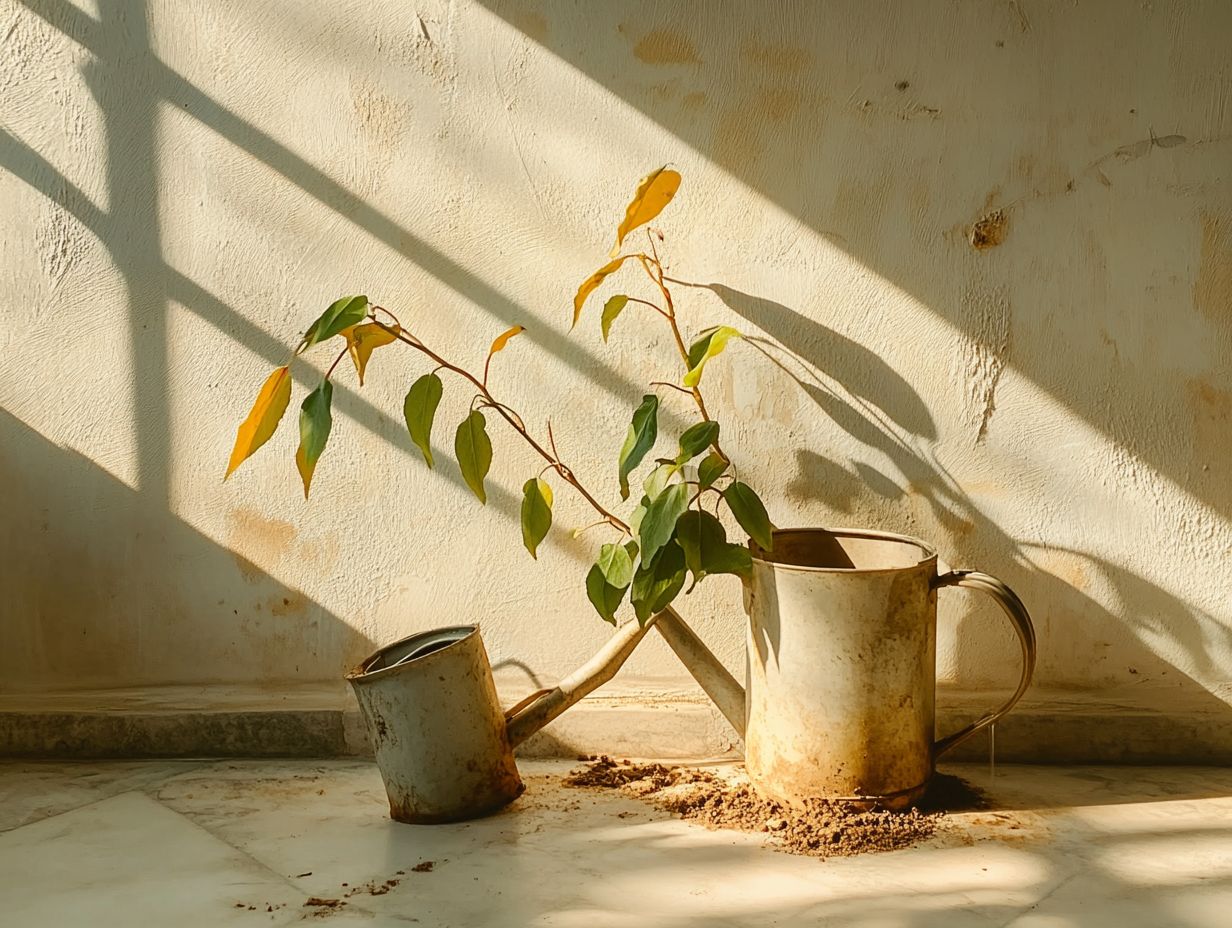
Visual cues like browning leaves, curling foliage, and the telltale yellowing can be significant indicators that your plants are suffering from underwatering. By being attentive to these symptoms, you can spring into action to revive your greenery and maintain optimal moisture levels.
A moisture meter a tool that checks how wet the soil is can be your best friend, providing concrete data on soil moisture and helping you diagnose potential issues before they escalate.
On the flip side, signs of overwatering might include soggy soil, root rot, and even mold growth issues that can easily be mistaken for drought stress. To truly differentiate between these conditions, it s essential to regularly inspect both the soil and the overall health of your plants.
Watch for signs of distress in your plants to identify if they’re suffering from water stress due to either underwatering or overwatering. Utilizing moisture meters not only eliminates the guesswork from your watering routine but also enables you to create a consistent care strategy.
Paying attention to how watering needs fluctuate with the changing seasons can significantly enhance the health and longevity of your plants. This practice makes it easier for you to make informed and effective decisions.
How to Properly Water Your Plants
Properly watering your plants requires an understanding of good methods and the establishment of a consistent watering schedule to achieve optimal hydration without the risk of overwatering.
A wise practice is to regularly check the soil moisture, enabling you to make informed decisions about when it s time to water.
Watch for signs of distress in your plants to identify if they’re suffering from water stress.
Best Practices for Watering
Adopting best practices for watering can significantly elevate your plant care routine, ensuring your houseplants stay healthy and vibrant. By incorporating a moisture meter into your watering habits, you can gauge soil moisture accurately, effectively preventing both underwatering and overwatering.
Proper drainage in your container plants is essential to avoid root rot and an array of complications. Understanding the specific needs of each plant species is crucial for customizing your watering schedule.
Some plants thrive in consistently moist soil, while others prefer drier conditions, so tailoring your approach is key.
Utilizing tools like watering cans with a long spout will allow you to deliver water directly to the roots without unnecessary splashing. Timing is everything; watering in the early morning or late afternoon optimizes moisture retention, allowing your plants to absorb water before the heat of the day kicks in.
Follow these tips carefully, and you’ll see your indoor garden thrive like never before!
Preventing Underwatering
Preventing underwatering is crucial for maintaining the health of your plants and avoiding distress symptoms associated with inadequate hydration.
By implementing a consistent watering schedule tailored to your plants’ specific needs and factoring in environmental elements like humidity and temperature, you can greatly enhance their growth and vitality.
Tips for Keeping Plants Properly Hydrated

To keep your plants properly hydrated, it s crucial to adopt effective watering techniques and utilize tools like a moisture meter for accurate soil assessment. Regularly checking the soil not only helps you diagnose potential issues but also ensures that your plants remain healthy and vibrant.
Establishing a consistent watering routine is equally vital, as it allows your plants to adapt to their moisture needs over time. Pay attention to your plants for signs of stress, such as drooping leaves or discoloration; these cues can provide valuable insights into their hydration levels, and recognizing symptoms of plant dehydration can help you respond promptly.
When using moisture meters, strive for a balance, ensuring that the top inch of soil demonstrates adequate moisture before watering again. Consider varying your watering methods; for instance, deep soaking can encourage root growth, while misting proves beneficial for tropical species.
By adapting your approach based on each plant’s specific requirements, you ll cultivate a flourishing garden that thrives under your care.
Start applying these tips today, and watch your garden flourish like never before!
Dealing with Underwatered Plants
Addressing underwatered plants demands your prompt attention to restore and nurture those displaying distress signals, like drooping leaves or parched soil. If you see wilting leaves, don’t wait! Your plant needs your help now.
Utilizing a moisture meter can be an invaluable tool in gauging the soil’s hydration level. This enables you to devise a tailored recovery strategy that breathes new life into your green companions.
Reviving and Caring for Damaged Plants
Reviving and caring for your damaged plants requires a careful plan to tackle water stress and restore their vitality. By nurturing your plants with proper watering techniques and considering a repot into lightweight soil, you can effectively alleviate the signs of underwatering and encourage new growth.
It s essential to ensure your watering schedule strikes the right balance think deep yet infrequent watering sessions. Check how well the soil drains. This is critical for your plants’ health.
Adjusting your care practices might also involve providing indirect sunlight or tweaking humidity levels, as these elements play a significant role in their recovery. Regularly check for signs of trouble like yellowing leaves. Intervening quickly can save your plants.
Frequently Asked Questions
What are the signs that my plant is underwatered, and how can I differentiate them from symptoms of overwatering?

The first sign that your plant is underwatered is wilting leaves. The leaves may also turn yellow or brown and feel dry to the touch. You may notice that the soil is dry and pulling away from the sides of the pot.
Can underwatered plants be saved?
Yes, underwatered plants can often be saved if you catch the problem early enough. Water the plant thoroughly and make sure the soil is evenly moist. You may also want to mist the leaves to help revive the plant.
How often should I water my plants?
This depends on the type of plant and its specific watering needs. Generally, water your plants when the top inch of soil is dry. Make sure to water regularly.
Are there any common mistakes that can lead to underwatering?
Yes, one common mistake is relying solely on a watering schedule instead of checking the moisture of the soil. Another mistake is not adjusting watering frequency based on environmental factors, such as changes in temperature or humidity.
Can overwatering mimic the symptoms of underwatering?
Yes, overwatered plants can also show wilting leaves and yellow or brown discoloration. However, in this case, the leaves may be soft and mushy instead of dry and crispy. Overwatering can also lead to root rot and other issues, so pay attention to the signs and adjust your watering routine accordingly.
What should I do if I suspect my plant is underwatered?
If you notice signs of underwatering, act quickly. Water the plant thoroughly and make sure the soil is evenly moist. Consider adjusting your watering routine to prevent the plant from becoming dehydrated in the future.

